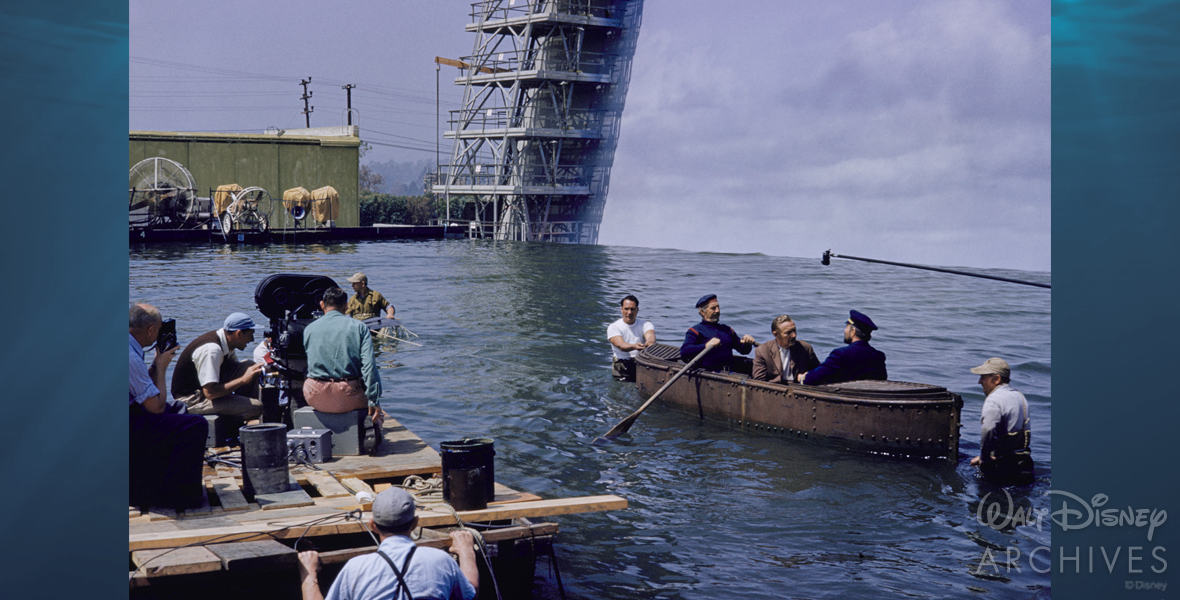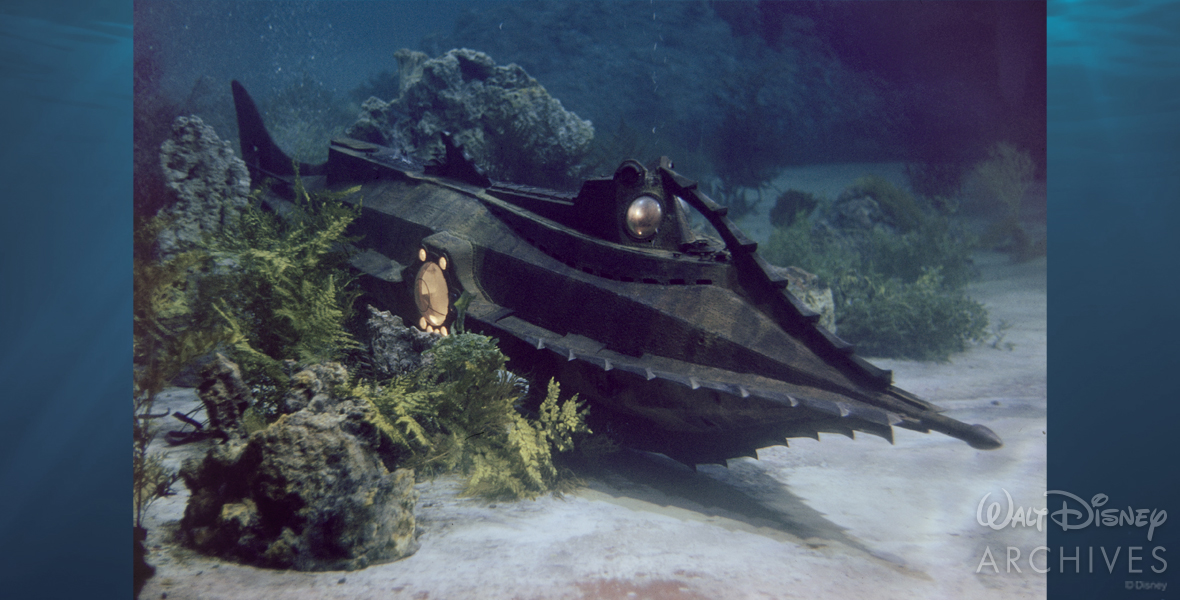By Devorah Burgess, Walt Disney Archives
Dive, dive, dive!
The year is 1868. Vessels traveling the heavy shipping lanes of the Pacific Ocean are threatened by a terrifying menace believed to be a strange monster. The peculiar creature is, in reality, a man-made submarine called the Nautilus—a self-contained vessel operated by cosmic power and headed by the eccentric genius Captain Nemo.
Seventy years ago, on December 23, 1954, Walt Disney’s Academy Award®-winning 20,000 Leagues Under the Sea first dove onto the big screen. Adapted by The Walt Disney Studios from the pages of Jules Verne’s science-fiction novel to a feature-length motion picture epic, the film has harpooned the hearts of generations. The story follows Professor Pierre Aronnax (Paul Lukas) of the Paris National Museum—positioned as the foremost authority on the sea and its mysteries—his apprentice, the reluctant Conseil (Peter Lorre), and heroic harpooner Ned Land (Kirk Douglas), who are all part of the crew assigned to hunt the monstrous creature—which leads them to Captain Nemo (James Mason).
Walt Disney had long admired the works of Verne and had the idea to make a film adaptation of 20,000 Leagues Under the Sea early in his career. The project was proposed as a True-Life Adventures-type subject, and for a short period was even considered as an animated project, until Hollywood art director (and future Disney Legend) Harper Goff—who shared a love of Verne—intervened:
“Walt went to England for many, many, many weeks for a role. I just fantasized on the idea of making it a live-action film. I didn’t draw it as a cartoon. I just worked from the book. It was empirical. It followed every incident that was in Jules Verne’s original. When Walt came back, he just raised one eyebrow, as if to say, ‘When the cat’s away the mice will play.’ He said, ‘What do you expect it to do?’ And I said, ‘This is live action, you know, I just thought you might do live action.’” —Harper Goff, artist and production designer

When Walt studied Goff’s story sketches, the fate of the film was transformed. The opportunity to combine Technicolor®and the groundbreaking new CinemaScope® process—of filming underwater and bringing to the screen Verne’s Nautilus, giant squid, and well-known characters—appealed to his imagination and storytelling instincts. Not one to repeat himself, Walt had established a reputation for exploring new and different directions, and this project offered the perfect opportunity to do so.
Walt Disney and his staff embarked on a whale of a tale to create this film. 20,000 Leagues Under the Sea was the first big-budget live-action feature shot at The Walt Disney Studios in Burbank. The studio once solely focused on animated films was now bustling as a new sound stage and shops were constructed to accommodate the film’s expanding production needs. Walt also set about recruiting some of Hollywood’s leading filmmakers: Ralph Hammeras (miniature effects photographer), Franz Planer (cinematographer), Emile Kuri (set decorator), and Richard Fleischer (director).
“The story of my getting the job of directing 20,000 Leagues Under the Sea is in my view one of the most bizarre and fantastic things that ever happened to me. My father, Max Fleischer, and Walt Disney were great competitors. So it was a great surprise to me when Walt offered me the job directing 20,000 Leagues Under the Sea.” —Richard Fleischer, director
Fleischer brought along collaborator and American screenwriter Earl Felton to the studio. The two would spend many long nights in their office in the Animation Building writing the script. Walt, personally invested in the project, would stop by regularly to offer Felton new dialogue and other ideas.
20,000 Leagues Under the Sea was filmed at three separate studios. At the Disney studio, the Nautilus interior, deck, and underwater miniature scenes were filmed, with a purposely built water effects tank constructed in the new Soundstage 3. The Western set used to depict 1860s San Francisco was located at the Universal Studios lot. Meanwhile, miniature effects shots and some other scenes were filmed at the Twentieth Century-Fox studios using a 22-foot-long Nautilus.

To achieve the mesmerizing underwater scenes set at the sunken island of Crespo, production also took place in Nassau, The Bahamas. Lyford Cay, at the western tip of New Providence Island, was selected as the ideal filming location because of its clear water. (Coincidentally, it was the same location where the 1916 silent film version of 20,000 Leagues Under the Sea had been filmed.) More than 20 tons of equipment, including three special underwater cameras, were transported to set, including experimental one-of-a-kind diving gear designed to meet the production’s needs and story elements. The equipment was shipped in from the Burbank studio lot after only being tested in a shallow pool!
“It was quite an adventure. People were scuba diving before that word had been invented. Everything they were doing down there was experimental. It was a pretty amazing operation.” —Disney Legend Roy E. Disney, later Vice Chairman of The Walt Disney Company
The diving suits, designed by Harper Goff with technical support from diving expert Fred Zendar, combined a diver’s helmet (styled after those used by Japanese pearl divers), a 150-pound rubber suit, and a disguised breathing apparatus. Lead weights were used in the boots to keep the actors from floating up.

Actors only had about an hour’s worth of air in their tank. It took 20 minutes to don diving gear, 10 minutes to get each person underwater, and another 10 to get them up to the surface, leaving only a few minutes to film a given scene. A series of hand signals were used to communicate efficiently with actors and crew underwater. Given this time-consuming process—and with the sun offering the only light source—up to four dives could be performed per day. The undersea funeral sequence alone took eight days to complete, featuring 11 actors and 22 crew members, all underwater.
“[For the funeral sequence,] there was a stretcher that four of us carried that had the ‘dead’ crew member on it…. The crew member was made out of chicken wire. It was a beautiful job; it looked like a person…. Captain Nemo got in front of the coral and put his cross down, and then, when he put his hands down, we were supposed to turn around to the side and pick up the coral and gently place it on the body. But the only problem was there wasn’t enough room to turn around. Well, time was going by, and everybody was getting panicked. What we were doing was picking up the coral and throwing it on him…. We smashed that poor guy down to nothing. It was just a flat sheet now. Nobody was smiling when we got up on the ship, but no one said anything.” —Bill Stropahl, stunt diver
The Nautilus was designed by Harper Goff with the utmost detail. Plans were drawn to plot the location of the cabins, salon, decks, and various rooms. Goff’s design was inspired by Verne’s own description of the submarine, which featured technologies envisioned years before they would become reality. By combining futuristic, piston-driven mechanisms with 19th-century elegance, Goff achieved a meticulous Victorian-futuristic aesthetic—something we might call “steampunk” in today’s terms. Great care was taken to evoke a feeling of warmth and sophistication, down to the leather-bound books on Captain Nemo’s shelves. The sub is both modern and a step back in time—it feels real, like you could live in it.
“One of the prime points made by Verne in the original story was that most of the people [who] had seen it described it as a monster, as a sea monster,” Goff would recount. “The two most awesome sea creatures that I had ever seen were the shark and the alligator.” Taking the dorsal fin of a shark and applying the eyes and rough skin of an alligator, the enduring image of Disney’s Nautilus was born.
Meanwhile, the interiors were based on the layout and warm woodwork of the USS Oregon battleship, built in the 1890s. The set was designed such that the entire layout could be viewed in almost every shot—walls, floor, and ceiling—intending to evoke in the audience a feeling of claustrophobia. This presented a challenge to the lighting designers, who would resort to hiding the lights in pieces of furniture.

The film’s musical score was composed by Disney Legend Paul Smith, who spent most of his career at The Walt Disney Studios and ultimately received eight Academy Award nominations (including one win for Original Score for Pinocchio [1940]). He wrote the background music for almost all the True-Life Adventures and nearly 70 animated shorts and felt that his music was a way of drawing the audience to the film.
“A sweet, gentle, quiet gentleman with great talent.… He wrote beautifully, but he wrote to service the film.… It was wonderful because he made every scene come to life with his gentle magic.… 20,000 Leagues is one of his finest pieces of work. It is a majestic score. It had great scope. It went from big exploding feelings to very subtle gentle things to scary things to eerie. He did a remarkable job in that film.” —Disney Legend and songwriter Richard M. Sherman
Captain Nemo’s theme was written to a piece of poetry by lyricist Hazel “Gil” George, who happened to be the studio nurse. George later recalled the moment Smith reached out to collaborate: “He called me and said, ‘See if you can write a poem or anything that might give me a kickoff on this.’” George jotted down the phrase “Deep is the mighty ocean,” which became the basis for the theme that represents both the sea and the depths of Nemo’s soul. To achieve an “underwater” orchestral effect, Smith used a combination of low strings and woodwinds—five clarinets, a piano, a harp, a gong, and a bass marimba.

A second theme is the iconic number that Kirk Douglas performs in the film—“A Whale of a Tale,” written by Norman Gimbel (words) and Al Hoffman (music). The theme is used in the dozen or so sequences that feature Ned Land and comedic elements, but it is also heard when Ned heroically saves Captain Nemo. What could have been an isolated song that wouldn’t bear much on the plot became the defining sound of a character and the film.
When asked to perform “A Whale of a Tale,” Kirk Douglas did not hesitate. “I’m not a singer, but I knew that the song would help establish the character,” he would later share with the Chicago Tribune. “I rehearsed it thoroughly, and when it came time to film, we got it done in very few takes.” He said that his grandson had memorized the number and sometimes sang it for him. “The first time he did it, he took me completely by surprise. That’s a wonderful feeling. It’s one thing knowing that another generation still remembers your song. But when it’s your own grandson… it’s great, just great.”

Perhaps the most famous scene from 20,000 Leagues Under the Sea is the battle against the giant squid, which was filmed on the newly built Soundstage 3. The squid was operated by puppeteers using cables that led up to the ceiling. This special effect would prove to be one of the most difficult to shoot. Looking back on the production, director Richard Fleisher recalled that the first attempt at a squid figure was akin to a sponge. Whole tentacles would fall off, so waterlogged they would snap the wires that were meant to control them.
The color and shape of the squid was redesigned by sculptor Chris Mueller, while special effects expert Bob Mattey combined two tons of rubber, flexible tubing, plastics, and steel springs to achieve fluid movement with the tentacles. This allowed every arm to be fully functional; the squid could move its head, roll its eyes, and snap its beak. It took 28 people to bring it to life. To create the effect of rain, the studio used some 30 wind machines (made from old airplane engines and propellers) and poured water into the wind stream to achieve the sideways effect of the water. Roy E. Disney would recall, “Water was flowing out of every door of the soundstage about a foot deep.”

20,000 Leagues Under the Sea was nominated for three Academy Awards, winning for Best Special Effects and Best Art Direction – Color. The film was so beloved that it spurred attractions in Disney Parks around the world. Shortly after its release, Walt Disney decided to display the film’s original sets in Tomorrowland at Disneyland Park. The 20,000 Leagues Under the Sea Exhibit proved to be a popular attraction and remained at the park for some 11 years (from August 3, 1955, to August 28, 1966). A similar walk-through attraction, Les Mystères du Nautilus, opened at Disneyland Paris on July 4, 1994, with elaborate set pieces recreating the famed Nautilus.
At Walt Disney World Resort, the Fantasyland submarine attraction 20,000 Leagues Under the Sea debuted on October 14, 1971. While Disneyland had based its “liquid space” attraction on the nuclear submarines that had been so much in the news in the late 1950s, the Imagineers decided instead to pattern their 12 submarines for the new Magic Kingdom Park after the Nautilus—with narration supplied by Captain Nemo himself (voiced by longtime Disney actor Pete Renoudet). It quickly became one of the most popular attractions in the park. After nearly 23 years, the attraction closed on September 5, 1994.

Aboard the Disney Treasure, the newest ship in the Disney Cruise Line fleet, guests can step inside the adult-exclusive Periscope Pub. Set in the Nautilus submarine, this adult-exclusive lounge features treasures and artifacts from Captain Nemo’s travels, and a view of the watery world above through a “glass” ceiling. Undersea-inspired drinks include three exclusive tap beers uniquely themed to the 1954 film and former Walt Disney World attraction.
At Tokyo DisneySea, the port of call known as Mysterious Island is themed to the works of Jules Verne (and shares a name with Verne’s serialized follow-up to 20,000 Leagues). Here, Captain Nemo’s scientific base has been constructed using Victorian-era principles, employing massive iron supports, panels, and girders, but carefully designed to co-exist within the fragile ecosystem and natural wonders of a volcanic crater. In the attraction 20,000 Leagues Under the Sea, guests join Captain Nemo’s crew and undertake a mysterious deep-sea mission aboard a six-passenger submarine, encountering shipwrecks, sea monsters, and intelligent denizens from the undersea civilization of Atlantis!
If you’re looking to glimpse original props used in 20,000 Leagues Under the Sea, head over to the Walt Disney Presents gallery attraction at Disney’s Hollywood Studios, where a Nautilus crew dive helmet, dive boots, and undersea rifle from the Walt Disney Archives collection are on display. Also featured is one of two Oscars® (Best Special Effects) awarded to the film, accepted by Walt Disney in 1955.
Blending boundary-breaking innovation, ambitious special effects, and creative storytelling, Walt Disney’s 20,000 Leagues Under the Sea was a groundbreaking achievement, successfully adapting Jules Verne’s imaginative novel into a visual masterpiece and leaving an enduring legacy that continues to ripple across popular culture and Hollywood history. Seventy years later, Walt’s first cinematic epic remains a testament to his mightiest ambitions and to his studio’s lasting ability to captivate audiences, taking them on an unforgettable journey to the depths of the ocean… and beyond.
20,000 Leagues Under the Sea is now streaming on Disney+.



